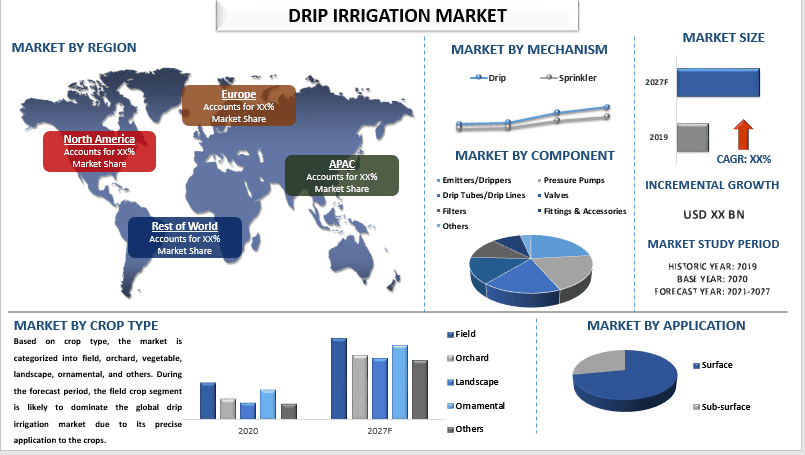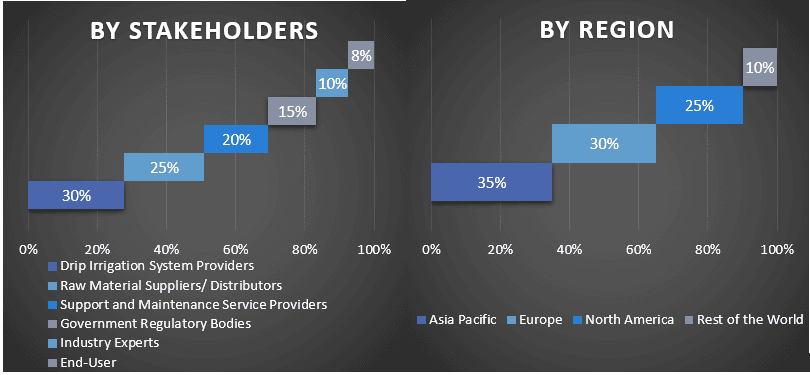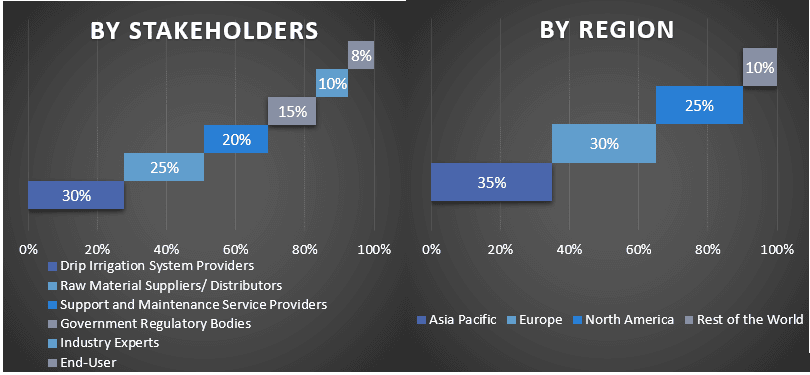Emphasis on the Mechanism (Drip and Sprinkler), Application (Surface, and Sub-Surface), Component (Emitters/Drippers, Pressure Pumps, Drip Tubes/Drip Lines, Valves, Filters, Fittings & Accessories, and Others), Crop Type (Field, Orchard, Vegetable, Landscape, Ornamental, and Others) and Region/Country

The global drip irrigation market is expected to witness a CAGR of around 11% during the forecast period (2021–2027). Drip Irrigation is also known as trickle irrigation or micro-irrigation, it involves dripping water onto the soil at very low rates. It is highly beneficial for the farmers as it has a parameter that helps in preventing 50% energy efficiency and 70% water efficiency. It is a low-pressure, precision-delivery irrigation system. It is a type of micro-irrigation procedure that ensures the slow application of water to the soil surface consistently during a longer period through small diameter tubes and pipes delivered at the root zone of the plants, drop by drop via drippers. The main objective of the drip irrigation system is to ensure wastewater management. The drip irrigation method does not permit water loss due to evaporation, deep percolation, and run-off in sandy soils.
Moreover, factors such as growing population and increasing global food demand. In addition, major players such as Chinadrip Irrigation Equipment Co. Ltd, Jain Irrigation Systems Ltd, Rivulis Irrigation Ltd, and many others in the market are continuously developing solutions for the drip irrigation market. For instance, In August 2019, a satellite-based software solution called ‘Manna’ was launched by Rivulis Irrigation to provide better solutions for drip irrigation systems.
Chinadrip Irrigation Equipment Co. Ltd, Jain Irrigation Systems Ltd, Rivulis Irrigation Ltd, Lindsay Corporation, EcofloIndia, Netafim Limited, Rain Bird Corporation, Hunter Industries, Elgo Irrigation Ltd., The Toro Company are some of the key players in the market. Several M&As along with partnerships have been undertaken by these players to boost their presence in different regions.
However, COVID– 19 has devasted the global economy restriction on movement imposed by the government to reduce the spread of the coronavirus had negatively impacted various industries, and drip irrigation was also affected. In addition, irrigation agencies around the world have continued to function despite challenging circumstances. However, there have been multiple shocks impacting service delivery, such as fiscal constraints, interruption of supply chains due to travel restrictions, and lack of availability of labor which negatively impacted the market size of drip irrigation.
Insights Presented in the Report
“Amongst Mechanism, Drip category to hold a significant share in the market”
Based on the mechanism, the market is fragmented as drip and sprinkler. The drip caters to an extensive share in the drip irrigation market and is expected to witness influential growth during the forecasted period. Drip irrigation is a process in which water flows through narrow pipes laid on the fields and drips through small holes (emitters) directly at the place of plant roots. Drip is a modern method of irrigation that is helping in using water economically. As roots absorb the water and nourish the plant and no water is wasted with this method. In addition, less water is lost to evaporation, runoff, and wind. Since the level of groundwater is going down, the use of drip segments is higher in the process to prevent the shortage of water. Furthermore, drip irrigation is used in the regions where the supply of water is less, and farmers growing high–value crops that substantially benefit the growth and quality of crops.
“Amongst Application, Surface category to hold a significant share in the market”
Based on application, the market is categorized into the surface, and sub-surface. During the forecast period, the surface segment is likely to dominate the global drip irrigation market. As they are well-designed irrigation equipment that enhances agricultural production and reassures the economic vitality of the farmer. In addition, surface drip irrigation equipment is widely used to irrigate perennial crops (trees and vines), vegetable crops, and annual row crops which in turn is escalating the market size of the drip irrigation system. Surface equipment utilizes water, which is applied over the soil by drip tubes or laterals.
“Amongst Component, Emitters/Drippers to hold a significant share in the market”
Based on components, the market is fragmented into emitters/drippers, pressure pumps, drip tubes/drip lines, valves, filters, fittings & accessories, and others. During the forecast period, the emitters/drippers segment is likely to dominate the global drip irrigation market. As it helps in no water clogging and controls the flow of water into the root zone at a specific rate. Moreover, a drip irrigation setup is easy to install in any commercial or residential area. They have different shapes and sizes such as flat boat-shaped, cylindrical, and can be attached to the inner wall of the lateral. They usually help to grow field crops or crops inclined in the row format. The inline emitter installation help in the cancellation cost of additional emitters, which is indirectly increasing the demand for emitters.
“Amongst Crop Type, Field Crop to hold a significant share in the market”
Based on crop type, the market is categorized into field, orchard, vegetable, landscape, ornamental, and others. During the forecast period, the field crop segment is likely to dominate the global drip irrigation market due to its precise application to the crops. In addition, it offers benefits such as reduced costs, higher profit margins, and lesser water and fertilizer requirements. Moreover, the consumption of field crops such as vegetables, onion, corn, and other crops is quite high over the world, and it is very profitable which in turn is catering extensive share in drip irrigation market.
APAC to witness significant growth during the forecast period”
APAC is expected to witness significant growth in the drip irrigation market during the forecast period. The major contributors to the growth of this market are due to developing countries such as India & China. As rising technology and up-gradation in the agriculture industry, coupled with escalating farmers’ awareness about modern farming techniques and irrigation systems such as precision irrigation systems are positively escalating the market outlook. In addition, the government is also offering high subsidies on its installation and providing micro-irrigation to the farmers. Furthermore, agriculture is turning its focus from traditional to commercial crops to provide better cultivation and more usage within the regions. Due to these changes, irrigation facilities are expected to modernize their irrigation management and preferably their infrastructure. For instance, In May 2020, The Toro Aqua-Traxx Azul clog-resistant drip tape was launched by Toro Company to provide a filter inlet design and optimized flow passages that pass-through debris to maximize clog resistance and product performance.
Reasons to buy this report:
Customization Options:
The global drip irrigation market can further be customized as per the requirement or any other market segment. Besides this, UMI understands that you may have your own business needs, hence feel free to connect with us to get a report that completely suits your requirements.
1. Market Introduction
2. Research Methodology Or Assumption
3. Market Synopsis
4. Executive Summary
5. Global Drip Irrigation Market Covid-19 Impact
6. Global Drip Irrigation Market Revenue (usd Bn), 2020-2027f
7. Market Insights By Mechanism
8. Market Insights By Application
9. Market Insights By Component
10. Market Insights By Crop Type
11. Market Insights By Region
12. Drip Irrigation Market Dynamics
13. Drip Irrigation Market Opportunities
14. Drip Irrigation Market Trends
15. Value Chain Analysis
16. Competitive Scenario
17. Company Profiled
18. Disclaimer
Research Methodology for the Global Drip Irrigation Market Analysis (2021-2027)
Analyzing the historical market, estimating the current market, and forecasting the future market of the global drip irrigation market were the three major steps undertaken to create and analyze the adoption of drip irrigation in major regions globally. Exhaustive secondary research was conducted to collect the historical market numbers and estimate the current market size. Secondly, to validate these insights, numerous findings and assumptions were taken into consideration. Moreover, exhaustive primary interviews were also conducted, with industry experts across the value chain of the global drip irrigation market. Post assumption and validation of market numbers through primary interviews, we employed a top-down/bottom-up approach to forecasting the complete market size. Thereafter, market breakdown and data triangulation methods were adopted to estimate and analyze the market size of segments and sub-segments of the industry pertains to. Detailed methodology is explained below:
Seek More Details About Research Methodology
Analysis of Historical Market Size
Step 1: In-Depth Study of Secondary Sources:
Detail secondary study was conducted to obtain the historical market size of the drip irrigation market through company internal sources such as annual reports & financial statements, performance presentations, press releases, etc., and external sources including journals, news & articles, government publications, competitor publications, sector reports, third-party database, and other credible publications.
Step 2: Market Segmentation:
After obtaining the historical market size of the drip irrigation market, we conducted a detailed secondary analysis to gather historical market insights and share for different segments & sub-segments for major regions. Major segments included in the report as mechanism, application, component, and end-user. Further country-level analyses were conducted to evaluate the overall adoption of testing models in that region.
Step 3: Factor Analysis:
After acquiring the historical market size of different segments and sub-segments, we conducted a detailed factor analysis to estimate the current market size of the drip irrigation market. Further, we conducted factor analysis using dependent and independent variables such as various mechanisms, applications, components, and end-user of drip irrigation equipment. A thorough analysis was conducted for demand and supply-side scenarios considering top partnerships, mergers and acquisitions, business expansion, and product launches in the drip irrigation market sector across the globe.
Current Market Size Estimate & Forecast
Current Market Sizing: Based on actionable insights from the above 3 steps, we arrived at the current market size, key players in the global drip irrigation market, and market shares of the segments. All the required percentage shares split, and market breakdowns were determined using the above-mentioned secondary approach and were verified through primary interviews.
Estimation & Forecasting: For market estimation and forecast, weights were assigned to different factors including drivers & trends, restraints, and opportunities available for the stakeholders. After analyzing these factors, relevant forecasting techniques i.e., top-down/bottom-up approach were applied to arrive at the market forecast about 2027 for different segments and sub-segments across the major markets globally. The research methodology adopted to estimate the market size encompasses:
Market Size and Share Validation
Primary Research: In-depth interviews were conducted with the Key Opinion Leaders (KOLs) including Top Level Executives (CXO/VPs, Sales Head, Marketing Head, Operational Head, Regional Head, Country Head, etc.) across major regions. Primary research findings were then summarized, and statistical analysis was performed to prove the stated hypothesis. Inputs from primary research were consolidated with secondary findings, hence turning information into actionable insights.
Split of Primary Participants in Different Regions

Market Engineering
The data triangulation technique was employed to complete the overall market estimation and to arrive at a precise statistical number for each segment and sub-segment of the global drip irrigation market. Data was split into several segments & sub-segments post studying various parameters and trends in the areas of various mechanisms, applications, components, and end-user in the global drip irrigation market.
The main objective of the global Drip Irrigation Market Study
The current & future market trends other than the global drip irrigation market were pinpointed in the study. Investors can gain strategic insights to base their discretion for investment on the qualitative and quantitative analysis performed in the study. Current and future market trends determined the overall attractiveness of the market at a regional level, providing a platform for the industrial participant to exploit the untapped market to benefit from a first-mover advantage. Other quantitative goals of the studies include:

Customers who bought this item also bought